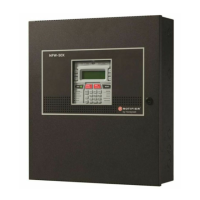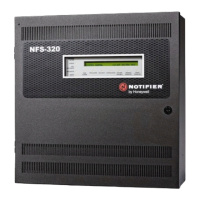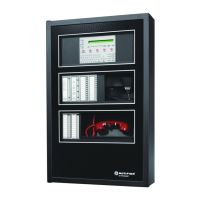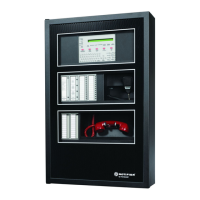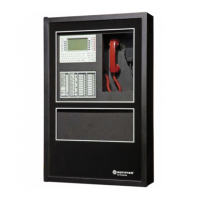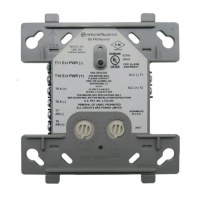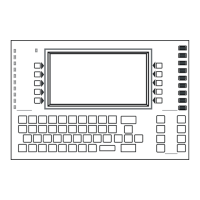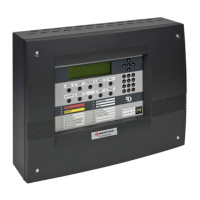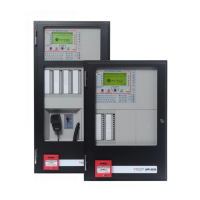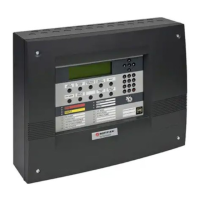NFW-100X Manual — P/N LS10131-001NF-E:C 7/25/2018 83
Master Programming Level Programming
DHCP Enabled
If the internet router used by the IPOTS-COM is configured for DHCP (Dynamic Host Configuration Protocol) where addresses are
automatically assigned, press 1 while viewing the IP Settings Screen to change the display to Enabled Yes. Each press of the 1 key will
cause the display to toggle between Enabled Yes and Enabled No. If the DHCP is enabled, the Static Settings option will disappear since
there is no need to enter addresses manually.
Static Settings
The Static Settings are used to set the addresses manually if the DHCP is not enabled. Press 2 on the IP Set-
tings Screen. The following screens will display:
The A flashing cursor will appear on the first X to the left. Enter the twelve digit address. When the address has been entered, press the
Enter key to store the address number. The display will return to the IP Settings Screen.
PIN
In the event that the Communicator needs to be replaced, the device will need to be re-registered with
AlarmNet. AlarmNet will issue a PIN to be entered into the panel for verification. Pressing 3 on the IP Set-
tings screen will display the following.
Enter the 4 digit PIN provided by AlarmNet and press Enter. The display will indicate that it is sending the PIN to AlarmNet for verifica-
tion.
Ethernet Fault
The Ethernet Fault Time is the duration of the communication loss between the FACP and the Ethernet
infrastructure.
Pressing 1 on the IP Settings Screen #2 will display the following:
Select the number of minutes allowed, 1-60, before a fault is shown on the panel.
Cellular Fault
The Cellular Fault Time is the duration of the communication loss between the FACP and the cellular infrastructure (e.g. cell tower).
Pressing 2 on the IP Settings Screen #2 will display the following:
Select the number of minutes allowed, 1-60, before a fault is shown on the panel.
Primary and Secondary Communication Paths
The Primary and Secondary Communication Path screens are used to configure the methods (primary and
backup) for reporting to central station. Pressing 1 for Pri or 2 for Sec will display the following screens.
IP SETTINGS
1=DHCP ENABLED NO
2=STATIC SETTINGS
3=ENTER PIN
IP Settings Screen
STATIC SETTINGS
DEVICE IP ADDRESS
XXX.XXX.XXX.XXX
Device IP Address Screen
STATIC SETTINGS
SUBNET MASK
XXX.XXX.XXX.XXX
Subnet Mask Screen
STATIC SETTINGS
GATEWAY IP ADDRESS
XXX.XXX.XXX.XXX
Gateway IP Address Screen
STATIC SETTINGS
PREFERRED DNS
XXX.XXX.XXX.XXX
Preferred DNS Screen
IP SETTINGS
1=DHCP ENABLED NO
2=STATIC SETTINGS
3=ENTER PIN
IP Settings Screen
IP SETTINGS
ENTER 4 DIGIT
PIN NUMBER
PIN Number Screen
IP SETTINGS
1=ETHERNET FAULT 01
2=CELLULAR FAULT 01
IP Settings Screen #2
ETHERNET FAULT TIME
RANGE 1-60 MINUTES
Ethernet Fault Time Screen
CELLULAR FAULT TIME
RANGE 1-60 MINUTES
Cellular Fault Time Screen
COMMUNICATOR
1=PRI COMM PATH
2=SEC COMM PATH
3=TBL CALL LIMIT 0
Communicator Screen #1
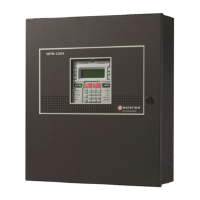
